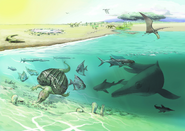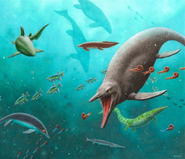| Ichthyosauria Fossil range: Middle Triassic to Late Cretaceous | |
|---|---|
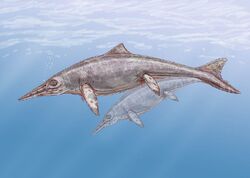 A pair of Shastasaurus altispinus. | |
| Scientific classification
| |
|
Ichthyopterygia | |
|
Ichthyosauria | |
| |
Ichthyosaurs (Greek for 'fish lizard') were giant marine reptiles that resembled fish and dolphins. Ichthyosaurs thrived during much of the Mesozoic era; based on fossil evidence, they first appeared approximately 245 million years ago (mya) and disappeared about 90 million years ago, about 25 million years before the dinosaurs became extinct. During the Middle Triassic Period, ichthyosaurs evolved from as-yet unidentified land reptiles that moved back into the water, in a development parallel to that of modern-day dolphins and whales.
Most ichthyosaurs were small, attaining sizes similar to that of the modern-day dolphin. However, a recent discovery of a seventy-foot ichthyosaur in British Columbia is the largest marine reptile ever found.[1] It's skull alone measures at approximately 19 feet long.
Ichthyosaurs were particularly abundant in the Jurassic Period, until they were replaced as the top aquatic predators by plesiosaurs in the Cretaceous Period. Ichthyosaur fossils have been found on every continent except Africa and Antarctica (other researchers reported finding possible ichthyosaur teeth in Antarctica, but they weren't enough to convince most paleontologists). They belong to the order known as Ichthyosauria or Ichthyopterygia ('fish flippers' - a designation introduced by Sir Richard Owen in 1840, although the term is now used more for the parent clade of the Ichthyosauria).
Description[]

Fischsaurier, Ichthyosauria, Holzmaden, Museum Wiesbaden Naturhistorische Landessammlung. Found in the Posidoniaschiefer formation of the Schwarzjura of Southern Germany (Toarcian, Lower Jurassic)
Ichthyosaurs averaged two to four metres in length (although a few were smaller, and some species grew much larger), with a porpoise-like head and a long, toothed snout. Built for speed, like modern tuna, some ichthyosaurs appear also to have been deep divers, like some modern whales (Motani, 2000). It has been estimated that ichthyosaurs could swim at speeds up to 40 km/h (25 mph).[2] Similar to modern cetaceans such as whales and dolphins, they were air-breathing and also were viviparous (some adult fossils have even been found containing fetuses). Although they were reptiles and descended from egg-laying ancestors, viviparity is not as unexpected as it first appears. All air-breathing marine creatures must either come ashore to lay eggs, like turtles and some sea snakes, or else give birth to live young in surface waters, like whales and dolphins. Given their streamlined bodies, heavily adapted for fast swimming, it would have been difficult for ichthyosaurs to scramble successfully onto land to lay eggs.
Research done into the braincase and ear structure have shown that ichthyosaurs were incapable of using echolocation, much in the same way that bats do today. However, recent studies conducted upon the braincase and bone structure of the head reveal that some species of ichthyosaur may have had sensitive skin along their beaks, aiding in the pursuit and location of prey items.
According to weight estimates by Ryosuke Motani [2], a 2.4 meter (8 ft) Stenopterygius weighed around 163 to 168 kg (360 to 370 lb), whilst a 4.0 meter (13 ft) Ophthalmosaurus icenicus weighed 930 to 950 kg (about a ton).
Although ichthyosaurs looked like fish, they were not. Biologist Stephen Jay Gould said the ichthyosaur was his favorite example of convergent evolution, where similarities of structure are analogous not homologous, for this group:
converged so strongly on fishes that it actually evolved a dorsal fin and tail in just the right place and with just the right hydrological design. These structures are all the more remarkable because they evolved from nothing — the ancestral terrestrial reptile had no hump on its back or blade on its tail to serve as a precursor.
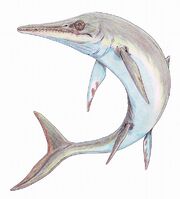

Fossil of a young Stenopterygius Ichthyosaur from the zoological museum of Hamburg.
Multiple ichthyosaur specimens recovered from lagerstätte in Germany and other locations have shown the preserved outlines of their bodies. Before these discoveries, the earliest reconstructions of ichthyosaurs omitted the dorsal fin, which had no hard skeletal structure, until finely-preserved specimens recovered in the 1890s from the Holzmaden lagerstätten in Germany revealed traces of the fin. Unique conditions permitted the preservation of soft tissue impressions.[3]
Ichthyosaurs had fin-like limbs, which were possibly used for stabilisation and directional control, rather than propulsion, which would have come from the large shark-like tail. The tail was bi-lobed, with the lower lobe being supported by the caudal vertebral column, which was "kinked" ventrally to follow the contours of the ventral lobe.
Apart from the obvious similarities to fish, the ichthyosaurs also shared parallel developmental features with dolphins. This gave them a broadly similar appearance, possibly implied similar activity, and presumably placed them broadly in a similar ecological niche.
Eyes[]
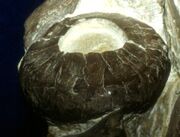
Ichthyosaur eye showing the sclerotic rings.
Typical ichthyosaurs have very large eyes, protected within a bony ring, suggesting that they may have hunted at night. Ichthyosaurs had exceptionally well-developed sclerotic rings, as in the right photograph, which fossilize fairly well.
In the 1950s, an observation was made that sclerotic rings were particularly well-developed in the animals whose eyes were not spherical. So it is believed that the ring helps keep the eyes in shape, at least in some animals. Ichthyosaurs had very flattened eyeballs, so it could well be that the sclerotic ring was useful in keeping the eyeballs in shape.

There is another reason why shape-keeping may have been necessary for ichthyosaurian eyes. When a fish-shaped object moves forward in water, some part of it is pushed by the surrounding water while the other parts are pulled. It is usually the front part of the fish that is pushed most strongly, and then there is no pull or push near the eye area (figure right). As you go further posteriorly, the force changes to pulling by the opercular area. So, for a fish, eye is located in a safe spot. In ichthyosaurs, however, eyes are disproportionally large. It is expected that the anterior part of their eyeball be pushed while the posterior part is pulled just by swimming. So, it is probably beneficial to have a bony structure in the eyeball to keep its shape. This applies regardless of water depth.
The largest ichthyosaurian eye that have been measured are 264 mm across, and belong to a Temnodontosaurus platyodon specimen. Ophthalmosaurus has an average eye size of 23 centimeters across.
Flippers[]

The limb skeletons went through a drastic modification as ichthyosaurs evolved.
Ichthyosaurs most likely used their forefins to maneuver during swimming, as in living fishes and cetaceans (dolphins and whales). Some paleontologists have suspected that certain ichthyosaurs used their limbs for propulsion, but it seems that their shoulders and hips were not very robust, unlike in vertebrates that use their limbs for propulsion.
The front paddles of ichthyosaurs evolved by losing the thumb, and adding more digits and wrist bones. Along the ichthyosaur family tree, the fossils of preserved fins have shown that fish-shaped ichthyosaurs lost the thumb bones present in the earliest ichthyosaurs. Additional evidence comes from studying the order in which digits became bony, or ossified, during the growth of the fish-shaped ichthyosaur Stenopterygius, for which we have specimens representing various growth stages. Later, additional fingers appeared on both sides of the preexisting ones, and some of them occupied the position of the lost thumb.
The following observations about the evolution of forefin skeletons in ichthyosaurs have been made: (1) The lower arm bones became shorter and shorter along the family tree, although there are exceptions; (2) The finger bones also became shorter and shorter, and eventually became disk-shaped; (3) The number of finger bone increased early in the evolution; (4) The thumb disappeared at one point, and then additional digits (light blue) appeared on both sides of the remaining digits.
Vertebrate[]
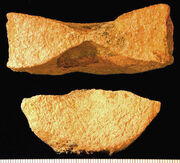
Ichthyosaur vertebrae from the Sundance Formation (Jurassic) of Natrona County, Wyoming. Note the characteristic"figure-8" cross-section for this variety. Scale in mm.
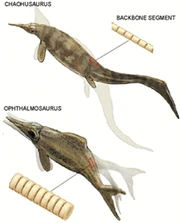
The narrow backbone of the first ichthyosaurs suggests that they undulated their bodies like eels (bottom). This motion allowed for the quickness and maneuverability needed for shallow-water hunting. As the backbone thickened in later ichthyosaurs, the body stiffened and so could remain still as the tail swung back and forth (bottom). This stillness facilitated the energy-efficient cruising needed to hunt in the open ocean.
Ichthyosaurs were typicaly thought to have backbones built from concave vertebrae in the shape of hockey pucks. This shape, though rare among diapsids, was always assumed to be typical of all ichthyosaurs. The first ichthyosaurs, which resembled primitive, eel-like reptiles, and descended from a lizardlike ancestor, swam by undulatory swimming, which requires a flexible body.
A crescent-shaped caudal fin, which acts as an oscillating hydrofoil, also improves their cruising efficiency. Fish-shaped ichthyosaurs had such a caudal fin, and their thick body profile implies that they probably swam like mackerel sharks. As the bodies of ichthyosaurs thickened over time, the number of vertebrae stayed about the same. To add support to the more voluminous body, the backbone became at least one and a half times thicker than those of the first ichthyosaurs. As a consequence of this thickening, the body became less flexible, and the individual vertebrae acquired their hockey-puck appearance.
Diet[]
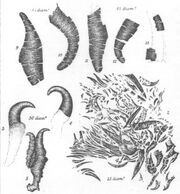
The preserved stomach contents of an ichthyosaur showing the creature fed upon belemnites
The diets of some ichthyosaurs are known from the stomach contents preserved in fossils. Since not every fossil comes with good stomach contents, our knowledge is limited to some fish-shaped ichthyosaurs.
Many of the ichthyosaurs relied heavily on ancient cephalopod kin of squids called belemnites for their diet. Some early ichthyosaurs had teeth adapted for crushing shellfish. They also most likely fed on fish, and a few of the larger species had heavy jaws and teeth that indicated they fed on smaller reptiles. Ichthyosaurs ranged so widely in size, and survived for so long, that they are likely to have had a wide range of prey.
As early as 1853, Coles noticed that there were unusual structures preserved in the trunk region of ichthyosaurs (figure left). He thought they might have been the scales of ichthyosaurs, but later scientists realized that these were indeed hooklets of squid-like creatures (extinct dibranchiate cephalopods, mostly belemnites, nautiloids, and ammonoids).
Recent evidence presented by Peter Doyle and Jason Wood (Holden, 2002), suggests that, at least some Jurassic ichthyosaurs that ate belemnites also regurgitated the skeletal, bony portions of the belemnite shells.
Since then, there have been several good studies on ichthyosaurian stomach contents, which revealed that many fish-shaped ichthyosaurs relied heavily on ancient kin of squids for their foods. Even Temnodontosaurus, a large Jurassic ichthyosaur that sometimes reached 10 meters in body length, had preference for squids, although it probably ate large vertebrates from time to time. Beside squid-like creatures, ichthyosaurs ate fish and other marine organisms.
The remains of turtle hatchlings have also been found in the stomach contents of ichthyosaurs (Kear, Benjamin P., South Australia Museum).
History of discoveries[]

Ichthyosaur mounted skeleton (Charmouth Heritage Coast Centre).

Fossil of a young Stenopterygius Ichthyosaur from the zoological museum of Hamburg.

Ichthyosaur skeleton from Holzmaden, Museum Wiesbaden

Ichthyosaurus tenuirostris skeleton.
The first fossil vertebrae were published twice in 1708 as tangible mementos of the Universal Deluge. The first complete ichthyosaur fossil was found in 1811 by Mary Anning in Lyme Regis, along what is now called the Jurassic Coast. She subsequently discovered three separate species.
Paleontologists drew these conclusions based solely on the exquisite skeletons of relatively late, fish-shaped ichthyosaurs. Bone fragments of the first ichthyosaurs were not found until 1927. The early lack of evidence so confused scientists that they proposed almost every major vertebrate group--not only reptiles such as lizards and crocodiles but also amphibians and mammals--as close relatives of ichthyosaurs. As the 20th century progressed, scientists learned better how to decipher the relationships among various animal species. On applying the new skills, paleontologists started to agree that ichthyosaurs were indeed reptiles of the group Diapsida, which includes snakes, lizards, crocodiles and dinosaurs. But exactly when ichthyosaurs branched off the family tree remained uncertain until paleontologists in Asia recently unearthed new fossils of the world's oldest ichthyosaurs.
The first big discovery occurred on the northeastern coast of Honshu, the main island of Japan. The beach is largely covered with slate outcrops, which contain fossils of the oldest known ichthyosaur, Utatsusaurus. Most Utatsusaurus specimens turn up fragmented and incomplete, but a group of geologists from Hokkaido University excavated two nearly complete skeletons in 1982.
In 1905, the Saurian Expedition led by John C. Merriam of the University of California and financed by Annie Alexander, found 25 specimens in central Nevada, which during the Triassic was under a shallow ocean. Several of the specimens are now in the collection of the University of California Museum of Paleontology. Other specimens are embedded in the rock and visible at Berlin-Ichthyosaur State Park in Nye County. In 1977, the Triassic ichthyosaur Shonisaurus became the State Fossil of Nevada. Nevada is the only state to possess a complete skeleton, 55 ft (17 m) of this extinct marine reptile. In 1992, Canadian ichthyologist Dr. Elizabeth Nicholls (Curator of Marine Reptiles at the Royal Tyrrell Museum) uncovered the largest fossil specimen ever, a 23 m (75 ft)long example.
Evolutionary history[]

Ophthalmosaurus icenius, from the Callovian period of the Middle Jurassic. This specimen was found in Oxford Clay, in Peterborough, England.

Grippia longirostris from the Early Triassic of Spitsbergen.
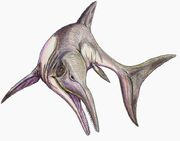
Platypterygius longmani
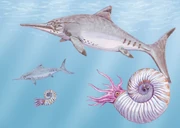
Ophthalmosaurus yasikovi from Upper Jurassic (Tithonian) of Volga region.
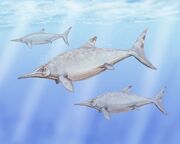
Otschevia zhuravlevi - from the lower Volgian (Tithonian, uppermost Jurassic) of Ulianovsk region.
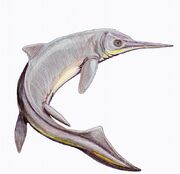
Contectopalatus atavus
Scientists were fairly confident that ichthyosaurs evolved from a smaller, land-dwelling, reptile. These ideas were reaffirmed with the discovery of two fossils of early ichthyosaur relatives. Utatsusaurus and Chaohusaurus are two ichthyosaurs that were disovered in Asia (Motani, 2000) that had limbs that looked akin to flippers. Analysis of Utatsusaurus hataii indicated that ichthyosaurs were in fact diapsids, however, not part of Sauria, which contains other reptiles such as lizards and crocodiles.
Early Ichthyosaurs[]
The earliest ichthyosaurs, looking more like finned lizards than the familiar fish or dolphin forms, are known from the Early and Early-Middle (Olenekian and Anisian) Triassic strata of Canada, China, Japan, and Spitsbergen in Norway. These primitive forms included the genera Chaohusaurus, Grippia, and Utatsusaurus. These early ichthyosaurs lacked a dorsal fin, and had a reptile-like tail. One intermediate species, Californosaurus perrini, shows signs of evolving a "tail bend", which would eventually evolve into the more fish-like tail for faster locomotion (Motani, pers. comm. 1999).
Triassic ichthyosaurs[]
These very early proto-ichthyosaurs, which are now classified as Ichthyopterygia rather than as ichthyosaurs proper (Motani 1997, Motani et al. 1998), quickly gave rise to true ichthyosaurs sometime in the latest Early Triassic or earliest Middle Triassic. These later diversified into a variety of forms, including the sea serpent like Cymbospondylus, which reached 10 meters, and smaller more typical forms like Mixosaurus. By the Late Triassic, ichthyosaurs consisted of both classic Shastasauria and more advanced, "dolphin"-like Euichthyosauria (Californosaurus, Teretocnemus) and Parvipelvia (Hudsonelpidia, Macgowania). Experts disagree over whether these represent an evolutionary continuum, with the less specialised shastosaurs a paraphyletic grade that was evolving into the more advanced forms (Maisch and Matzke 2000), or whether the two were separate clades that evolved from a common ancestor earlier on (Nicholls and Manabe 2001).
During the Carnian and Norian, shastosaurs reached huge sizes. Shonisaurus popularis, known from a number of specimens from the Carnian of Nevada, was 15 meters long. Norian shonisaurs are known from both sides of the Pacific. Himalayasaurus tibetensis and Tibetosaurus (probably a synonym) have been found in Tibet. These large (10 to 15 meters long) ichthyosaurs probably belong to the same genus as Shonisaurus (Motani et al, 1999; Lucas, 2001, pp.117-119). While the gigantic Shonisaurus sikanniensis, whose remains were found in the Pardonet formation of British Columbia by Elizabeth Nicholls, reached as much as 21 meters in length - the largest marine reptile known to date.
These giants (along with their smaller cousins) seemed to have disappeared at the end of the Norian. Rhaetian (latest Triassic) ichthyosaurs are known from England, and these are very similar to those of the Early Jurassic. Like the dinosaurs, the ichthyosaurs and their contemporaries the plesiosaurs survived the end-Triassic extinction event, and immediately diversified to fill the vacant ecological niches of the earliest Jurassic.
Ichthyosaur "Golden Age"[]
The Early Jurassic, like the Late Triassic, was the heyday of the ichthyosaurs, which are represented by four families and a variety of species, ranging from one to ten meters in length. Genera include Eurhinosaurus, Ichthyosaurus, Leptonectes, Stenopterygius, and the large predator Temnodontosaurus, along with the persistently primitive Suevoleviathan, which was little changed from its Norian ancestors. All these animals were streamlined, dolphin-like forms, although the more primitive animals were perhaps more elongated than the advanced and compact Stenopterygius and Ichthyosaurus.
Ichthyosaurs were still common in the Middle Jurassic, but had now decreased in diversity. All belonged to the single clade Ophthalmosauria. Represented by the 4 meter long Ophthalmosaurus and related genera, they were very similar to Ichthyosaurus, and had attained a perfect "tear-drop" streamlined form. The eyes of Ophthalmosaurus were huge, and it is likely that these animals hunted in dim and deep water (Motani 2000).
Ichthyosaurs seemed to decrease in diversity even further with the Cretaceous. Only three genera are known, Caypullisaurus, Maiaspondylus, and Platypterygius, although they had a worldwide distribution. This last ichthyosaur genus became extinct during the Cenomanian-Turonian extinction event early in the Late Cretaceous (as did the pliosaurs). Interestingly, less hydrodynamically efficient animals like mosasaurs and long-necked plesiosaurs flourished. It could be that the ichthyosaurian over-specialisation was a contributing factor to their extinction, possibly being unable to 'keep up' with the fast swimming and highly evasive new teleostei fish, which had become dominant at this time, against which the sit-and-wait ambush strategies of the mosasaurs proved superior (Lingham-Soliar 1999).
Migration to deep sea[]
Characteristics apart from diet and body shape also indicate that at least some fish-shaped ichthyosaurs were deep divers. The ability of an air-breathing diver to stay submerged depends roughly on its body size: the heavier the diver, the more oxygen it can store in its muscles, blood and certain other organs--and the slower the consumption of oxygen per unit of body mass. The evolution of a thick, stiff body increased the volume and mass of fish-shaped ichthyosaurs relative to their predecessors. Indeed, a fish-shaped ichthyosaur would have been up to six times heavier than a lizard-shaped ichthyosaur of the same body length. Fish-shaped ichthyosaurs also grew longer, further augmenting their bulk. Calculations based on the aerobic capacities of today's air-breathing divers (mostly mammals and birds) indicate that an animal the weight of fish-shaped Ophthalmosaurus, which was about 950 kilograms, could hold its breath for at least 20 minutes. A conservative estimate suggests, then, that Ophthalmosaurus could easily have dived to 600 meters--possibly even 1,500 meters--and returned to the surface in that time span. Bone studies also indicate that fish-shaped ichthyosaurs were deep divers. Limb bones and ribs of four-limbed terrestrial animals include a dense outer shell that enhances the strength needed to support a body on land. But that dense layer is heavy. Because aquatic vertebrates are fairly buoyant in water, they do not need the extra strength it provides. In fact, heavy bones (which are little help for oxygen storage) can impede the ability of deep divers to return to the surface. A group of French biologists has established that modern deep-diving mammals solve that problem by making the outer shell of their bones spongy and less dense. The same type of spongy layer also encases the bones of fish-shaped ichthyosaurs, which implies that they, too, benefited from lighter skeletons.
Taxonomy of species[]
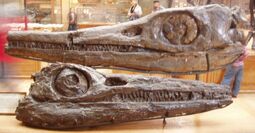
Skulls of Temnodontosaurus burgundiae from the Muséum national d'Histoire naturelle, Paris.

Temnodontosaurus platyodon on display at the Royal Ontario Museum, Toronto.
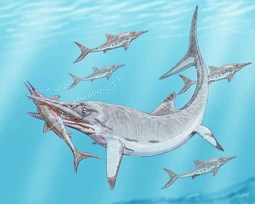
Temnodontosaurus burgundiae attacking Stenopterygius hauffianus. Lias of Germany.
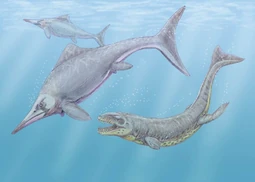
- Superorder Ichthyopterygia
- Family Grippidae
- Family Utatsusauridae
- Order ICHTHYOSAURIA
- Cymbospondylus
- Family Mixosauridae
- Suborder Merriamosauriformes
- Guanlingsaurus
- (unranked) Merriamosauria
- Infraorder Shastasauria
- Family Shastasauridae
- Shastasaurus
- Shonisaurus
- Himalayasaurus
- Tibetosaurus
- Family Shastasauridae
- Infraorder Ichthyosauria (=Euichthyosauruia)
- Family Ichthyosauridae
- Family Leptopterygiidae
- Leptonectes
- Eurhinosaurus
- Excalibosaurus
- Family Temnodontosauridae
- Family Ophthalmosauridae
- Family Stenopterygiidae
- Family Toretocnemidae
- Californosaurus
- Qianichthyosaurus
- Teretocnemus
- Family Suevoleviathanidae
- Suevoleviathan
- Infraorder Parvipelvia
- Hudsonelpidia
- Macgowania
Gallery[]
See also[]
References[]
- Ellis, Richard, (2003) Sea Dragons - Predators of the Prehistoric Oceans. University Press of Kansas ISBN 0-7006-1269-6
- Stephen Jay Gould, "Bent out of Shape" in Eight Little Piggies.
- Lingham-Soliar, T. (1999): A functional analysis of the skull of Goronyosaurus nigeriensis (Squamata: Mosasauridae) and Its Bearing on the Predatory Behavior and Evolution of the Enigmatic Taxon. N. Jb. Geol. Palaeont. Abh. 2134 (3): 355-74
- Maisch, M. W. & Matzke, A. T. (2000) The ichthyosauria. Stuttgarter Beitraege zur Naturkunde. Serie B. Geologie und Palaeontologie. 2000; (298): 1-159.
- McGowan, Christopher (1992) Dinosaurs, Spitfires and Sea Dragons, Harvard University Press, ISBN 0-674-20770-X
- McGowan, Christopher & Motani, Ryosuke, (2003) Ichthyopterygia, Handbook of Paleoherpetology, Part 8, Verlag Dr. Friedrich Pfeil
- Motani, R. (1997), Temporal and spatial distribution of tooth implantation in ichthyosaurs, in JM Callaway & EL Nicholls (eds.), Ancient Marine Reptiles. Academic Press. pp. 81-103.
- Motani, R. (2000), Rulers of the Jurassic Seas, Scientific American vol.283, no. 6
- Motani, R., Minoura, N. & Ando, T. (1998), Ichthyosaurian relationships illuminated by new primitive skeletons from Japan. Nature 393: 255-257.
- Motani, R., Manabe, M., and Dong, Z-M, (1999) The status of Himalayasaurus tibetensis (Ichthyopterygia) pdf, Paludicola2(2):174-181 June 1999
- Nicholls, E. L. & Manabe, M. 2001. A new genus of ichthyosaur from the Late Triassic Pardonet Formation of British Columbia: bridging the Triassic-Jurassic gap. Canadian Journal of Earth Sciences 38, 983-1002.
